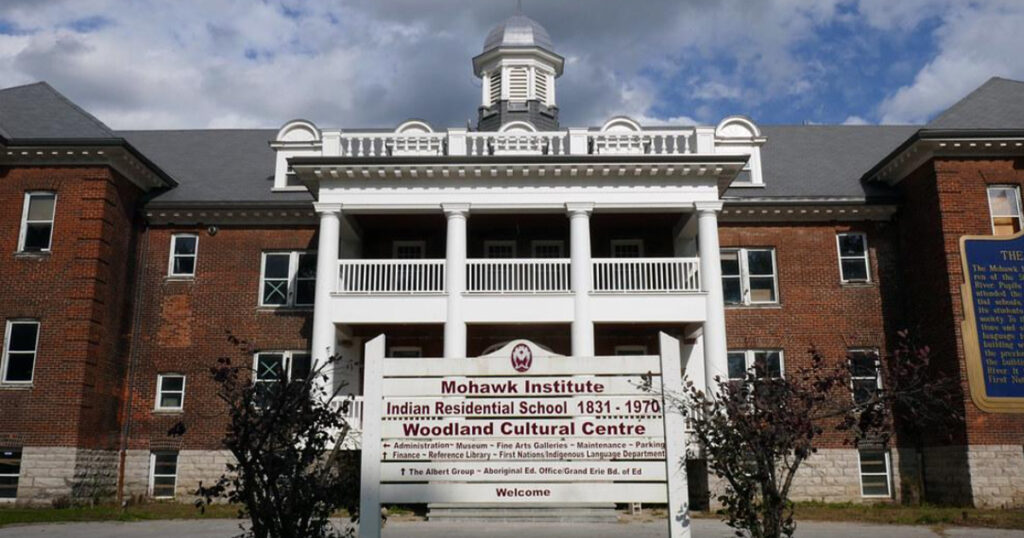Hymie Rubenstein is editor of The REAL Indian Residential Schools newsletter and a retired professor of anthropology, The University of Manitoba
Readers of True North know that the legacy media are some of Canada’s biggest peddlers of misinformation and disinformation – otherwise known as “fake news.”
There is no worse offender than the prestigious Globe and Mail.
Take this April 21 Globe and Mail editorial titled Will the head of the Anglican Church finally bring restitution to Indigenous peoples? The column claimed that “historical records show 48 children died” at the Mohawk Indian Institute operated by the Anglican Church of Canada.
This claim is misleading. Let me explain.
The Mohawk Institute opened in 1828 in Brantford, Ontario. The federal government took full responsibility for the school in 1945 and closed it in 1970.

Indeed, there are 48 allegedly missing Mohawk IRS children listed on the National Centre for Truth and Reconciliation Student Memorial Register. Where they died is unknown, and only two of the deaths are from the post-1941 period.
But calling these children “missing” is inaccurate. They are not missing, they are known to be dead.
Yes, their cause of death and place of burial are both unknown, but only because these were never investigated by the Centre’s many researchers.
The result is that there is no reason to suspect that they are any more “missing” than the two children still not accounted for among their 51 Kamloops Indian Residential School counterparts. Those children were found in historical school records, backed up by death certificates (see here and here) by a lone unpaid researcher, Nina Green. All were buried in named cemeteries – mainly on their home reserves.
Even though Ms. Green sent droves of information to dozens of media outlets, Indigenous leaders, academics, and government officials months ago, they were ignored.
Could this be because they contradicted the grievance narrative celebrated by agenda-driven woke activists like those who write at the Globe?
Objective research conducted by Green and others has revealed the fate of other so-called missing children — “so-called” because the whereabouts of their remains can easily be discovered by any serious researcher willing to dig through the schools’ archives and provincial death records.
These rich primary sources were either never properly studied or dismissed for their inconvenient truths by the extravagantly funded Truth and Reconciliation Commission of Canada charged with reporting on the history, operation, and legacy of the Indian Residential Schools.
Similar scurrilous claims of Indigenous children murdered by Roman Catholic priests and secretly buried in the dead of night next to their Kamloops Indian Residential School have been thoroughly discredited. Ongoing research is sure to keep showing that nearly all former students can be accounted for across Canada, as has already been done for British Columbia and elsewhere.
None were murder victims.
Globe-style falsehoods have been exposed only because of strict and impartial research – research now rejected by mainstream journalists, most academics, aboriginal leaders, and elected politicians in favour of Indigenous pre-scientific “ways of knowing.”
In the same piece, Globe and Mail columnist Tanya Talaga also writes that “thousands of children are now being recovered from the sites of schools just like the Mohawk Institute.”
This is plain factual nonsense since no confirmed missing children have ever been “recovered” from any newly discovered putative grave anywhere in Canada.
The “missing children” discovered by the often inconclusive technique called ground penetrating radar have no names attached to them. The technique is so vague and inconclusive, researchers can’t even be sure if they’re looking at graves or tree roots.
In order for remains to be “recovered,” as the Globe suggests, researchers would have to first confirm their existence and then presumably perform an excavation.
Talaga also shows or feigns ignorance of previous Mohawk Institute efforts to discover the burial of alleged missing children when she argues, “now, an exhaustive search is under way [sic] on 600 acres of Six Nations’ grounds for those who never went home.”
Though superficially true, this ignores a previous search for student bodies in 2013 that was not only inconclusive but also fabricated by Canada’s leading Indigenous conspiracy theorist, defrocked United Church minister Kevin Annett.
He was subsequently disavowed by the Mohawk leadership for his fraudulent claims. Annett’s inventions about the Mohawk Institute are eerily similar to the make-believe stories about the Kamloops Indian Residential School because the same man peddled both.
This has not prevented the burial-obsessed Trudeau federal government from allocating $10.2 million early this year for additional searches.
Talaga also speciously claims that the Indian Residential School system “was used as a tool of genocide” even though there is not a single verified case of a child murdered at any Indian Residential School during their 114-year government-funded operation (1883-1997).
Yes, the Truth and Reconciliation Commission employed the extra-legal term “cultural genocide” to characterize the school experience. But this hyper-inflammatory synonym for the ordinary enculturation of millions of non-English-speaking children has been going on since our country’s founding.
She also claims, with no supporting evidence, that the Indian Residential Schools engaged in “stealing children to send to these so-called schools” oblivious to the fact that researchers have reconfirmed what was always known to any credible historian: Indian Residential School attendance was never mandatory – except for orphaned, abandoned, or abused children.
Canada’s history is imperfect, and there is no greater example than our history with First Nations Canadians. But rather than exaggerate and politicize our history – based on sloppy postmodern reports filled with half-truths, inflammatory rhetoric and vitriolic emotion – we should make sure that facts and truths rule the day and guide us towards finding reconciliation.
